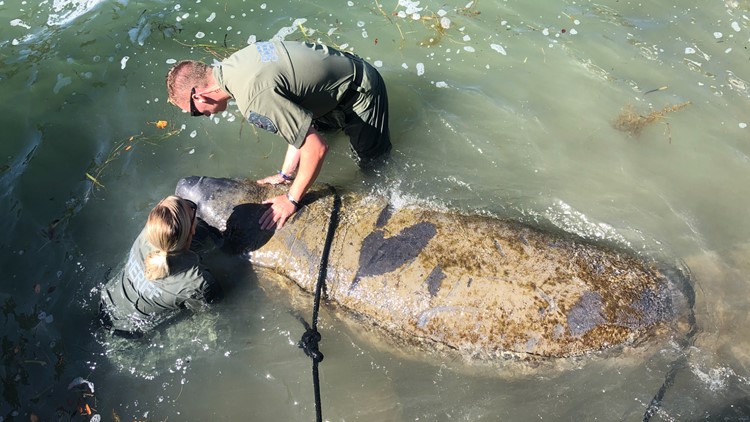PINELLAS COUNTY, Fla. — Deputies with the Pinellas County Sheriff's Office were able to work together to save a manatee that was in distress, a news release from the agency explained.
A few weeks ago when red tide levels were high, a deputy got a call from a woman who claimed there was something wrong with a manatee in the Intracoastal Waterway.
The agency explained some people misunderstand the behavior of manatees and call to report it – but once the deputies were on scene, they immediately knew the sea cow was actually in deep distress.
“We’re watching it, and it will not go underwater," Deputy Jill Constant stated in the release. "It just stayed at the surface with labored breathing."
The exhausted manatee reportedly tried to beach itself on the rocks so it wouldn't drown.
“We docked the boat, I took off my equipment, and got in," she said. "We stayed in the water for two hours holding its head up until it could be rescued.”
But the sea cow wasn't thrilled about being rescued.
“At the end of the process, it was not happy with us!" Constant explained. "At the beginning, it was too exhausted, but after a while, it had recovered its strength a little and it started thrashing.
"I thought I was going to drown – a martyr for the cause.”
Biologists with the Florida Fish and Wildlife Conservation Commission responded to the distressed manatee and it was believed the marine mammal would make a full recovery.
Currently, manatees are starving to death.
"It’s a staggering heartbreaking number for Floridians," J.P. Brooker, the Director of the Florida Conservation for Ocean Conservancy, previously explained.
Brooker said in just two years, the state has lost 25 percent of its manatee population. There are around 6,000 manatees in Florida. Brooker said it traces back to water quality.
"We’re putting too much stuff in the water and that’s creating a condition where manatees can’t thrive," Brooker said.
When fertilizer from your lawn or pet waste gets into the waterways, it creates nutrients that feed harmful algal blooms like red tide.
Seagrass is a manatee’s main food source. Brooker said manatees need to eat about 10 percent of their body weight every day to survive.
"That’s 100 pounds per manatee," Brooker added.
With recent harmful algal blooms, manatees aren't able to eat the seagrass they need to survive because it's dying and limited.
FWC keeps track of how many manatees die every year in Florida. So far this year, 332 have died.
Here's the five-year breakdown:
- 2022, there were 574 manatee deaths.
- 2021, there were 779 manatee deaths.
- 2020, there were 309 manatee deaths.
- 2019, there were 276 manatee deaths.
- 2018, there were 463 manatee deaths.
FWC reports the five-year average is 463 deaths.
10 Tampa Bay's Shannon Clowe contributed to this report.



